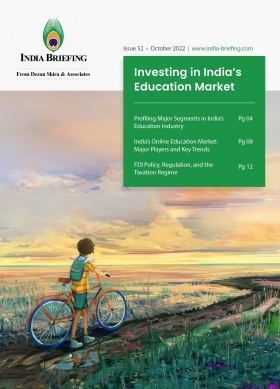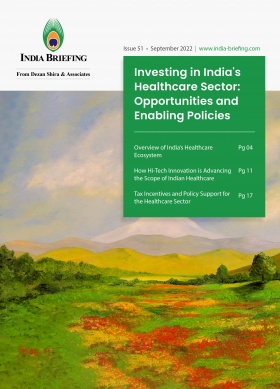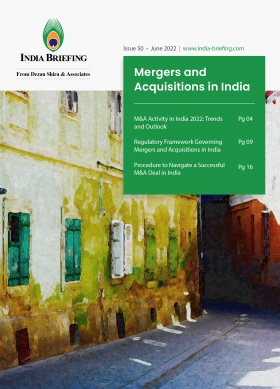India’s OTT Media Services Industry: Rapid Growth Amid Competition for Market Share
India’s OTT media services sector is expanding rapidly, doubling in size over the past four years. This article looks at the competition for market share among 40 platforms operating in the sector, the challenges being faced, and the competition for popular content.
Over-the-top (OTT) media services refer to a media service offered directly to viewers via the internet. Its growth around the world has come hand in hand with the rise of faster internet speeds and demand for a broader array of media products, from sports to movies and entertainment. In many countries, particularly in the West, OTT has replaced traditional TV broadcaster as the main medium for screen-based entertainment. These services have replaced scheduled broadcasting with on-demand programming.
Meanwhile, India has increased the foreign direct investment (FDI) limit from 74 percent to 100 percent in the media and entertainment industry.
How big is India’s OTT market?
India’s over-the-top media services industry will generate US$3 billion in revenue in 2022, representing a substantial increase on the pre-pandemic years. Research from independent transaction advisory firm RBSA Advisors suggests that the industry has been growing at a compound annual growth rate (CAGR) of 30.7 percent between 2019-2024.
The growth of OTT is expected to continue with new research from Media Partners Asia (MPA) highlighting a second growth phase. The company expects India’s OTT market to more than double in value to almost US$7 billion by 2027. The sector’s expansion has been accelerated by the stay-at-home entertainment consumption trends during the pandemic but also by India’s increasing internet-connected population – there are expected to be 900 million internet users in the country by 2025.
However, India’s OTT market size still lags that of China – APAC’s largest market which will generate $11.2 billion in revenue in 2022. The world’s most populous nation represents 48 percent of the APAC online video revenue pie. The region’s market size is anticipated to be US$49.2 billion by the end of the year, according to the MPA report.
According to the report, by the end of 2022, subscription video on demand (SVoD) will contribute 50 percent of revenues, UGC (user-generated) advertising-based video on demand (AVoD) will generate 37 percent and premium AVoD 13 percent for the APAC region as a whole.
International examples of AVoD include platforms like TikTok, Facebook Watch, YouTube, Instagram, and Vimeo–platforms that many people use every single day and are funded by advertising. SVOD allows consumers to access an entire catalog of content for a flat rate, typically paid monthly like Netflix or Amazon.
Meanwhile, Deloitte sees the OTT market growing at a CAGR of 20 percent over the next decade, generating a staggering US$13 billion–US$15 billion in 10 years’ time. In a 2022 report, the firm estimated that Indian subscriber figures will expand at 17 percent CAGR to reach 224 million by 2026 from the current 102 million.
In India, AVoD generates more revenue than SVoD. AVoD platforms are expected to continue to pull in more revenue than SVoD in the coming years, increasing from the current revenue generation of US$1.1 billion in 2021 to US$2.4 billion in 2026. Over the same period, SVoD is expected to grow from its current US$800 million to US$2.1 billion in 2026.
Consideration for market progression
Going forward it is likely that we will see more hybrid platforms develop, allowing customers to view content without adverts by paying on a traditionally AVoD platform, or vice-versa. MX Player – one of the largest OTT players operating on the AVoD (advertising video on demand) model – announced its premium ‘MX Gold’ product earlier this year. Other platforms, including Zee5, AltBalaji, and Disney+Hotstar, have already launched new offerings as part of a hybrid model.
Language is a major consideration within the OTT market in India. The share of regional language consumption on OTT platforms is expected to cross 50 percent by 2025 from 30 percent held in 2019, according to the Deloitte report. Hindi, the report claims, will represent around 45 percent of OTT platform content. It adds that platforms are also increasingly responding to regional demands for OTT, as well as those of Indian diaspora living abroad.
Deloitte highlights that India’s video streaming industry is highly fragmented. There are currently more than 40 operators, including global streaming service providers such as Amazon, Disney-owned Hotstar, and Netflix which compete with domestic service providers including Zee5, Voot, and MX Player.
The biggest players in India’s OTT market by subscriptions
|
Platform |
Subscribers |
|
Disney Hotstar |
42.9 million |
|
Amazon Prime |
21 million |
|
Sony Liv |
12 million |
|
Zee 5 |
7.5 million |
|
Netflix India |
5.5 million |
Source: Marketfeed, August 2022.
The sheer number of players could be seen as problematic. Arguably, in such an environment, it is hard for all the platforms to target a specific part of the market. Unless companies can find their niche, they may be forced to merge with peers.
Near-term trends
Increasing competition
The Deloitte report contends that the rise of OTT often comes at the expense of the broader media industry as subscribers move away from traditional linear TV. However, the report says this is yet to happen in India, and TV viewership is on the rise.
Instead, there are concerns that SVoD subscriptions may be affected by the “bring-forward” effect of Covid-19. In India, each paying customer has, on average, 2.4 subscriptions. But the pandemic and associated restrictions was likely responsible for accelerating the growth rate, which in turn may taper off with the virus subsiding.
As such, amid a highly competitive environment, featuring dozens of stakeholders, firms will likely have to invest in increasing their attractiveness to Indian customers. “The global OTT market may be saturated but continues to see churn which means platforms will have to invest in tentpole content and customer acquisition. India is early into the ecosystem but the Western trajectory is a pointer to what could follow here,” said Jehil Thakkar, partner and media and entertainment sector leader, Deloitte India.
The Deloitte report highlights that app aggregation and bundling may play an important role in expanding the market’s reach, providing affordability, and compatibility with existing devices.
According to MPA, new local players with deep pockets are set to add to the already competitive environment. A newly recapitalized Viacom18, backed by Reliance, Bodhi Tree, and Paramount are pushing forward to capture more of the market, while Zee and Sony are merging to create a strong television and online video business, the report said.
Viacom18’s new streaming platform will look to leverage Indian Premier League (IPL) Cricket, as well as locally produced entertainment shows, to attract customers within the AVoD space. The group also hopes to leverage its massive reach via Jio mobile and connected TV.
The role of popular content
With increasing competition for market share in OTT, companies have invested considerably in the sector which makes up 7-9 percent of its entertainment industry. According to Deloitte research, OTT platforms invested an estimated US$665 million in content in 2021, with Netflix, Amazon Prime, and Disney+ Hotstar leading the pack with a combined spend of US$380 million.
Disney’s Hotstar had previously been considered among the most popular OTT outfits in India, but it recently lost its online streaming contract for the IPL. India’s richest man – Mukesh Ambani – paid a hefty premium (US$3.04 billion) to acquire the digital rights for the IPL for subsidiary Viacom18. Disney-owned Star Sports India paid US$3.02 billion for the exclusive TV rights. The importance of the IPL is exacerbated by the relative lack of interest in other sporting competitions, such as English or Italian football, which are huge draws in other countries.
Bollywood – India’s and world’s largest film industry in terms of films produced and released each year – is also a draw for customers in India, and around the world. Some reports suggest that OTT has played an important role in sustaining Bollywood, claiming the platforms have become a home for the industry’s film flops. Nevertheless, Bollywood, along with other original and local OTT content, including Sacred Games and Kota Factory, have become huge draws for Indian customers. The growth of OTT in India will enhance the growth of the Indian entertainment industry as competition for content increases.
Growth of audio-visual sector and services
While the OTT market may appear saturated with 40 operators, it is also clear that there is a huge market for original and language-appropriate entertainment. The rapid growth of the industry is also creating opportunities in visual effects (VFX) – special effects added to a film using a computer.
India’s Animation, Visual Effects, Gaming and Comic (AVGC) sector is growing at a rate of ~29 percent, while the audio-visual sector and services is rising at the rate ~25 percent. The Indian government now recognizes AVGC as a champion sector; it is estimated to grow at ~9 percent to reach ~US$43.93 billion by 2024.
In April this year, the federal Ministry of Information & Broadcasting set up an AVGC Promotion Task Force. As per the ministry, India has the potential to capture five percent (~US$40 billion) of the global market share by the year 2025, with an annual growth of around 25-30 percent and creating over 160,000 new jobs annually.
India’s domestic market share of the AVGC sector is inclined to see huge growth with increased demand for high-quality content in commercials, web series, movies, and OTT programming. Within these diverse types of entertainment, there is a rising preference for cinematic and animated effects over live action.
About Us
India Briefing is produced by Dezan Shira & Associates. The firm assists foreign investors throughout Asia from offices across the world, including in Delhi and Mumbai. Readers may write to india@dezshira.com for more support on doing business in in India.
We also maintain offices or have alliance partners assisting foreign investors in Indonesia, Singapore, Vietnam, Philippines, Malaysia, Thailand, Italy, Germany, and the United States, in addition to practices in Bangladesh and Russia.
- Previous Article Business Opportunities in the Indian Solar Energy Sector
- Next Article India’s Tax Authority Considers Common Income Tax Return, to Include Crypto Assets Declaration








